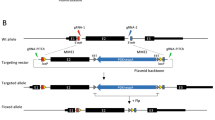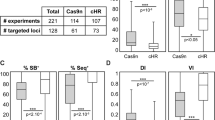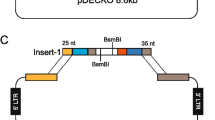Abstract
Functional characterization of gene(s) using a transgene approach in a human cell line or in an animal model generally poses limitations due to persistent transgene overexpression. Conversely, the CRISPR/Cas9 gene-editing technology enables precise variant(s) introduction in a gene, thus facilitating accurate characterization in human iPSC-derived target cell/tissue. Such editing is generally mediated by non-homologous end joining, the predominant and error-prone double-strand break repair mechanism which mostly results in gene knockout due to indel(s) generation. However, in most cases the best in silico predicted sgRNAs fail to generate indels especially in iPSCs, encouraging a revisit of DNA damage repair principles. Microhomology-mediated end joining (MMEJ) is another error-prone repair mechanism which relies on exposed microhomologous sequences flanking the broken ends to fix double-strand breaks. Therefore, sgRNAs targeting the exonic region encompassing di- or tri-nucleotide repeats along with non-repeat exonic region as control, in RIC3, a gene of our interest, were designed to generate effective indel(s) exploiting the MMEJ DSB repair mechanism. iPSCs were co-transfected with eCas9+EGFP and sgRNA+puromycin plasmids and positive clones enriched by transient puromycin selection. Multiple deletion lines adjacent to microhomologous (repeat) region and several lines heterozygous with only 1 bp insertion for the non-repeat region were obtained, and confirmed by Sanger sequencing. These findings suggest that (i) designing sgRNAs from different exonic regions with microrepeats and (ii) MMEJ combined with a rapid and less expensive method of using antibiotic screening of edited lines without cumbersome cell sorting may be effective strategies for indel(s) generation in stem cells.





Similar content being viewed by others
References
Avior Y, Sagi I and Benvenisty N 2016 Pluripotent stem cells in disease modelling and drug discovery. Nat. Rev. Mol. Cell Biol. 17 170–182
Burridge PW, Thompson S, Millrod MA, et al. 2011 A universal system for highly efficient cardiac differentiation of human induced pluripotent stem cells that eliminates interline variability. PLoS One 6 e18293
Dagdas YS, Chen JS, Sternberg SH, Doudna JA and Yildiz A 2017 A conformational checkpoint between DNA binding and cleavage by CRISPR-Cas9. Sci. Adv. 3 0027
Ebert AD, Liang P and Wu JC 2012 Induced pluripotent stem cells as a disease modeling and drug screening platform. J. Cardiovasc. Pharmacol. 60 408–416
González F 2016 CRISPR/Cas9 genome editing in human pluripotent stem cells: Harnessing human genetics in a dish. Dev. Dyn. 245 788–806
Hendriks WT, Warren CR and Cowan CA 2016 Genome editing in human pluripotent stem cells: approaches, pitfalls, and solutions. Cell Stem Cell 18 53–65
Hockemeyer D and Jaenisch R 2016 Induced pluripotent stem cells meet genome editing. Cell Stem Cell 18 573–586
Naeem M, Majeed S, Hoque MZ and Ahmad I 2020 Latest developed strategies to minimize the off-target effects in CRISPR-Cas-mediated genome editing. Cells 9 1608
Ran FA, Hsu PD, Wright J, et al. 2013 Genome engineering using the CRISPR-Cas9 system. Nat. Protoc. 8 2281–2308
Seol JH, Shim EY and Lee SE 2018 Microhomology-mediated end joining: Good, bad and ugly. Mutat. Res. 809 81–87
Steyer B, Bu Q, Cory E, et al. 2018 Scarless genome editing of human pluripotent stem cells via transient puromycin selection. Stem Cell Rep. 10 642–654
Wang H and Xu X 2017 Microhomology-mediated end joining: new players join the team. Cell Biosci. 7 6
Yu C, Liu Y, Ma T, et al. 2015 Small molecules enhance CRISPR genome editing in pluripotent stem cells. Cell Stem Cell 16 142–147
Zhang Z, Zhang Y, Gao F, et al. 2017 CRISPR/Cas9 Genome-editing system in human stem cells: current status and future prospects. Mol. Ther. Nucleic Acids 9 230–241
Acknowledgements
We gratefully acknowledge Grant #BT/PR27457/MED/12/811/2018 to BKT and Senior Research Fellowship to NY from the Department of Biotechnology, Government of India, New Delhi, and the Junior and Senior Research Fellowship (#325541-2017-22) to NY from University Grants Commission (UGC), New Delhi. The sequencing facility at the CIF, University of Delhi South Campus; the infrastructure support provided by UGC, New Delhi, through Special Assistance Programme; and the Department of Science and Technology, New Delhi, through FIST and DU-DST PURSE programme to the Department of Genetics, University of Delhi South Campus, are also acknowledged.
Author information
Authors and Affiliations
Corresponding author
Additional information
Corresponding editor: Shamik Sen
Supplementary Information
Below is the link to the electronic supplementary material.
Rights and permissions
About this article
Cite this article
Yadav, N., Thelma, B.K. Microhomology-mediated endjoining repair mechanism enables rapid and effective indel generations in stem cells. J Biosci 47, 72 (2022). https://doi.org/10.1007/s12038-022-00307-1
Received:
Accepted:
Published:
DOI: https://doi.org/10.1007/s12038-022-00307-1




